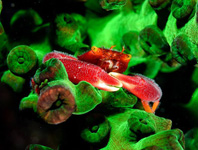Abstract
This study presents a review of the species Protankyra ramiurna Heding, 1928 and Protankyra benedeni (Ludwig, 1881) from the Brazilian coast. Some authors consider that these two taxa represent a single variable species. Our comparative analysis of external characters, anatomy and ossicle morphology indicates that they represent distinct species. This is the first record of Protankyra ramiurna from Brazil.
References
Alitto, R.A.S., Bueno, M.L., Di Domenico, M. & Borges, M. (2016) Annotated checklist of Echinoderms from Araçá Bay, Southeastern Brazil. Check List, 12 (1), 1836, 1–15.
https://doi.org/10.15560/12.1.1836Amaral, A.C.Z., Maccord, F.S., Borges, M. & Rizzo, A.E. (2011) Composição faunística de fundos não consolidados da plataforma interna. In: Amaral, A.C.Z. & Nallin, S.A.H. (Eds.), Biodiversidades e ecossistemas bentônicos marinhos do litoral norte de São Paulo. Sudeste do Brasil. Universidade Estadual de Campinas, Campinas, SP, pp. 435–458.
Brandt, J.F. (1835) Echinodermata ordo Holothurina. In: Brandt, J.F. (Eds.), Prodromus Descriptionis Animalium ab H. Mertensio in Orbis Terrarum Circumnavigatione Observatorum, Petropoli,75 (I), 42–62.
Brites, A.D., Hadel, V.F. & Tiago, C.G. (2011) Crinoidea, Asteroidea, Echinoidea, Holothuroidea. In: Amaral, A.C.Z. & Nallin, S.A.H. (Org.), Biodiversidade e ecossistemas bentônicos marinhos do Litoral Norte de São Paulo, Sudeste do Brasil. Campinas, SP, Universidade Estadual de Campinas, Instituto de Biologia, pp. 273–279.
Burmeister, H. (1837) Handbuch der Naturgeschichte. Zweite Abt Zoologie, Part 2, 369–858.
Clark, H.L. (1907) The Apodous Holothurians: A monograph of the Synaptidae and Molpadiidae, including a Report on the representatives of these families in the Collections of the United National Museum. Smithsonian Contributions Knowledge, 35, 1–231, 14 pls.
Deichmann, E. (1930) The Holothurians of the western part of the Atlantic Ocean. Bulletin of the Museum of Comparative Zoology at Harvard College, 71 (3), 42–276.
Hending, S.G. (1928) Papers from Dr. Th. Mortensen’s Pacific Expedition 1914–1916. XLVI. Synaptidae. Videnskabelige Meddelelser Dansk Naturhistorisk Forening, 85, 105–323.
Heding, S.G. (1931) Uber die Synaptiden des Zoologischen Museums zu Hamburg. Zoologische Jahrbücher, 61, 637–698.
Hendler, G., Miller, J.E., Pawson, D.L. & Kier, P.M. (1995) Sea Stars, Sea Urchins and allies: Echinoderms of Florida and the Caribbean. Smithsonian Institution Press, Washington, 392 pp.
Jans, D. & Jangoux, M. (1989) Functional morphology of vibratile urnae in the synaptid holothuroid Leptosynapta inhaerens (Echinodermata). Zoomorphology, 109, 165–171.
https://doi.org/10.1007/bf00312268Kerr, A.M. (2001) Phylogeny of the Apodan Holothurians (Echinodermata) inferred from morphology. Zoological Journal of the Linnean Society, 133: 53–62. Zoological Journal of the Linnean Society, 133, 53–62.
https://doi.org/10.1111/j.1096-3642.2001.tb00622.xLudwig, H. (1881) Über eine lebendiggebarende Synaptide und zwei andere holothurienarten des Brasilianischen kuste. Archives Italiennes de Biologie, 2, 41–58.
Montagu, G. (1815) An account of some new and rare marine British shells and animals. Transactions of the Linnean Society of London, 11 (2), 179–204, pls. 12–14.
https://doi.org/ 10.1111/j.1096-3642.1813.tb00047.xMoura, R.B., Rodrigues, D.S., Carvalho, A.L.P.S. & Campos, L.S. (2010) On the Holothuroidea from the collection of Echinodermata, Institute of Biology, Federal University of Rio de Janeiro, Brazil. In: Harris, L.G., Böttger, S.A., Walker, C.H. & Lesser, M.P. (Eds.), Echinoderms: Durham. Taylor & Francis Group, London, pp. 245–249.
https://doi.org/ 10.1201/9780203869543-c40Netto, L.F., Hadel, V.F. & Tiago, C.G. (2005) Echinodermata from São Sebastião Channel (São Paulo, Brazil). Revista de Biología Tropical, 53 (3) , 207–218.
Östergren, H. (1898) Das system der Synaptiden. Öfvers Kongelige Vetebskaps-Akademien Förhandlingar, 55, 111–120.
Pawson, D.L. (1965) New sea-cucumbers (Echinodermata: Holothuroidea) from New Zealand waters. Records Dominion Museum, 5, 75–82.
Pawson, D.L. (1967) Protankyra grayi new species and Labidoplax buskii (Mclntosh) from off North Carolina (Holothuroidea; Synaptidae). Proceedings of the Biological Society of Washington, 80, 151–156.
Pawson, D.L. (1970) The Marine Fauna of New Zealand: Sea Cucumbers. New Zealand Oceanographic Institute Memoir No. 52. Bulletin New Zealand Department Scientific Industrial Research, 201, 1–69.
Pawson, D.L., Pawson, D.J. & King, R.A. (2010) A taxonomic guide to the Echinodermata of the South Atlantic Bight, USA: 1. Sea cucumbers (Echinodermata: Holothuroidea). Zootaxa, Magnolia Press, 2449, 1–48.
Pires-Vanin, A.M.S., Muniz, P. & Bromberg, S. (2014) Inventory of the marine soft bottom macrofauna of São Sebastião Channel, southeastern Brazilian continental shelf. Check List, 10 (4), 795–807.
https://doi.org/10.15560/10.4.795Rowe, F.W.E. & Doty, J.E. (1977) The shallow water holothurians of Guam. Micronesica, 13 (2), 217–250.
Tommasi, L.R. (1969) Lista dos Holothuroidea recentes do Brasil. Contribuições Avulsas do Instituto Oceanográfico, série Oceanografia Biológica, 15, 1–29.
Tommasi L.R. (2004) Classes Asteroidea, Crinoidea, Holothuroidea & Echinoidea. In: Amaral, A.C.Z. & Rossi-Wontschowski, C.L.D.B. (Eds.), Biodiversidade bentônica da região Sudeste-Sul do Brasil: Plataforma Externa e Talude Superior. Instituto Oceanográfico,USP, Série Documentos Revizee Score Sul, São Paulo, pp. 161–164.
Ventura, C.R.R., Borges, M., Campos, L.S., Costa-Lotufo, V., Freire, C.A., Hadel, V.F., Manso, C.L.C., Silva, J.R.M.C., Tavares, Y. & Tiago, C.G. (2012) Echinoderm from Brazil: historical, research and the current state of biodiversity knowledge. In: Alvarado, J.J. & Solís-Marín, F. (Eds.), Echinoderm research and diversity in Latin America. Springer, pp. 301–344.
https://doi.org/10.1007/978-3-642-20051-9Verrill, A.E. (1885) Results of the explorations made by the Steamer Albatross off the northern coast of the United States, in 1883. Annual Report of the United States Commission of Fish and Fisheries, 11, 503–699.

